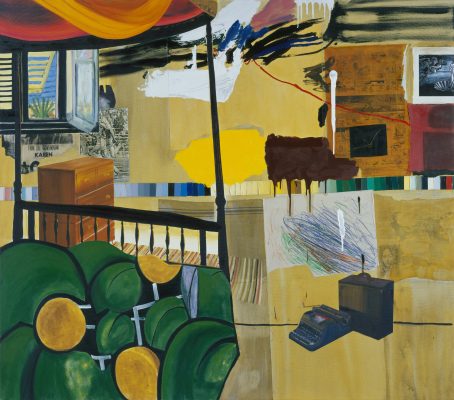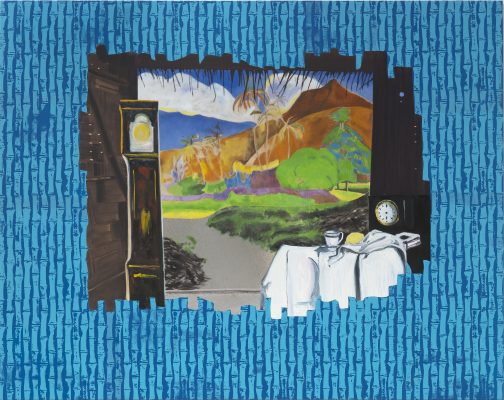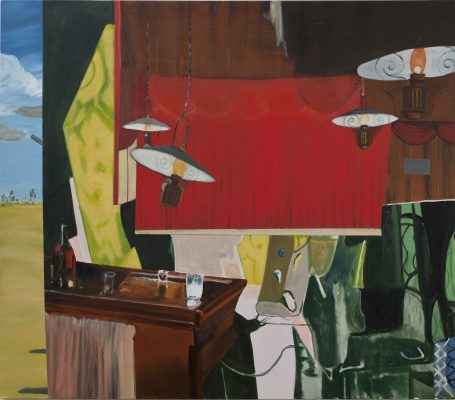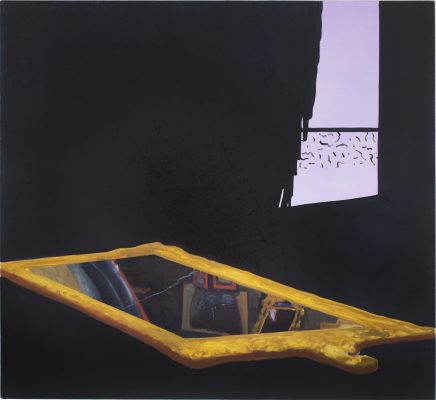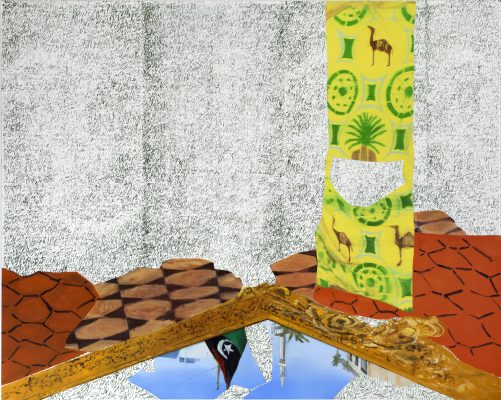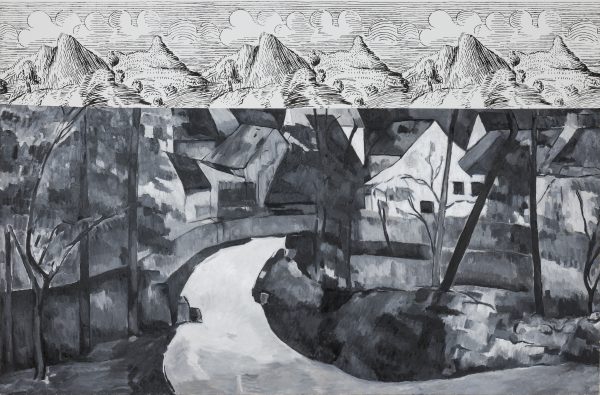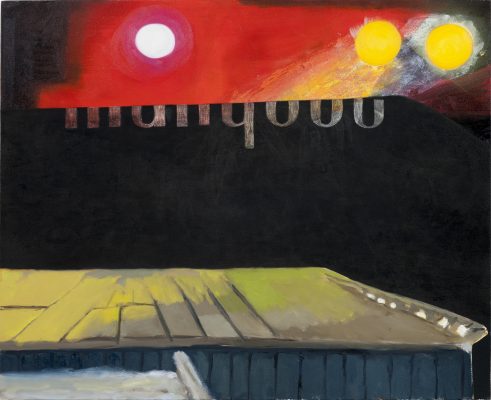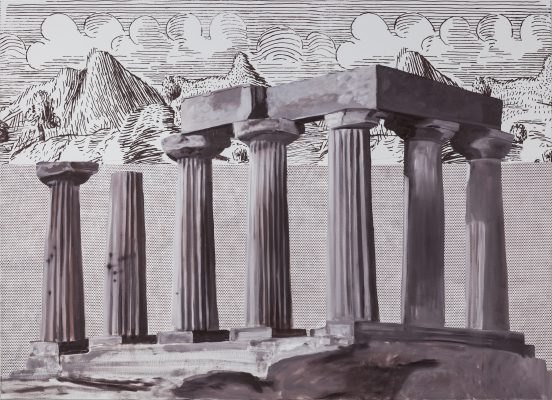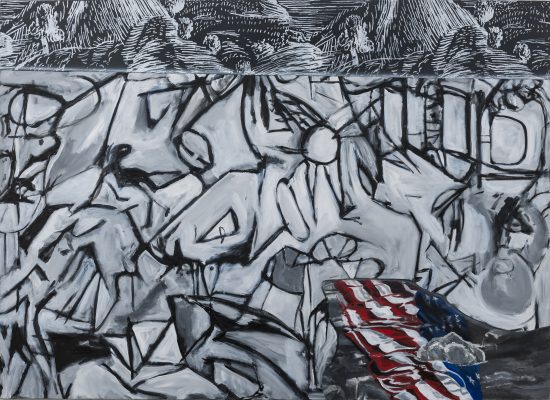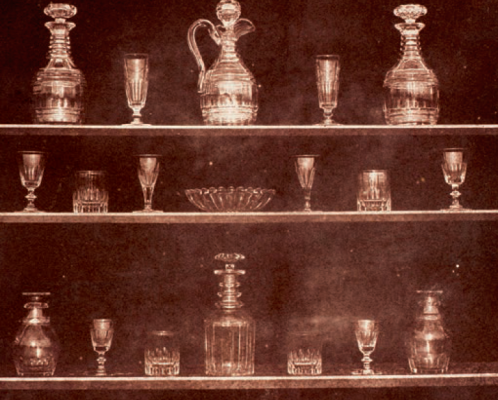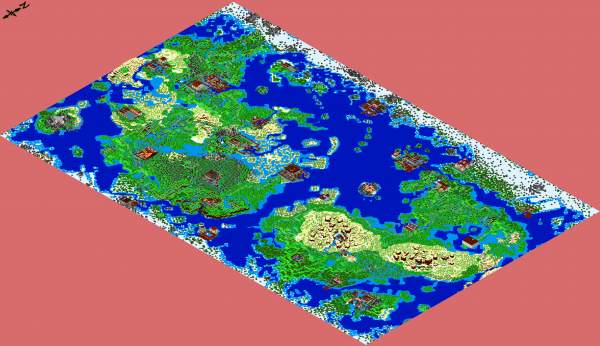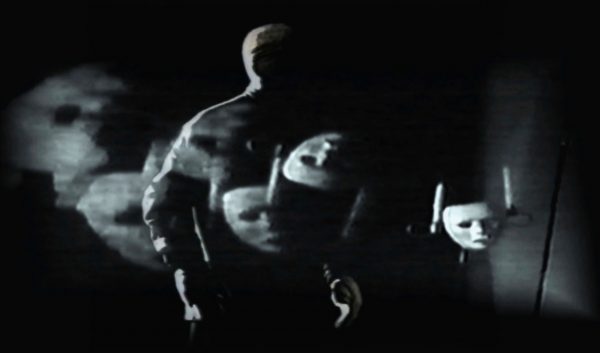‘Burroughs in Tangier’ (2005) has captivated me ever since its display in the 2010 Turner Prize Exhibition. The work is composed largely of art historical references; allusions to an interior scene of a hotel room [which, as the title suggests, might be the room in which the American novelist William S. Burroughs worked on the Interzone collection] inscribed with Twombly-esque wax crayon scribbles. The brushstrokes are vaguely reminiscent of some post-painterly abstraction. The linens recall Henri Rousseau’s primitivist floral structures, and, outside the window, one encounters the bright shade of blue Matisse used to depict the lightness found nowhere more than on the Côte d’Azur. Traces of what it means to spend a life as an exiled writer in the interzone of Tangier occupy every corner of the painting. Burroughs’ typewriter, or a poor reproduction of Botticelli’s ‘Venus’ decorating the hotel room, point to the anonymity of hotel rooms heightened by the way in which one encounters things that don’t belong. Yet what mesmerised me about this painting was not its subject, but the way in which the individual elements were composed into something entirely new. I have never seen a painting that so loudly screams: ‘I have a composition. Everything else is irrelevant.’
I was left with the feeling that there was something incomprehensibly singular about the painting, something I did not understand at all. I decided to visit Dexter Dalwood in his studio to find out more about the process behind this painterly experience. If I was at all apprehensive it was because of my reluctance to demystify such an experience with the knowledge of its production. Speaking with artists sometimes bears the danger of disillusionment; if I understand the painting better, will its affect suffer?
Luckily this was not the case. I did not learn much about ‘Burroughs in Tangiers’, but our discussion circled around various works in Dalwood’s studio due to be shipped out for his solo exhibition at the Centre PasquArt in Biel. However, discussing Dalwood’s more recent work illuminated his practice as a whole, helping me to figure ‘Burroughs in Tangier’ into a much broader understanding of the artist’s paintings.
The painting most indicative of his practice, and one of Dalwood’s most iconic, is ‘Robert Walser’ (2012), which hung on the wall facing me as I entered. It was immediately evocative of an unspecified painting by Paul Cézanne, one of the Mont Saint-Victoire near Aix-en-Provence. For ‘Robert Walser’ Dalwood relocated the magnificent mountain from the soft Mediterranean landscape into the harshness of Switzerland; a sweet French landscape painting now a hard Grisaille painting, stripping Cézanne of all his colour. By draining out the colour, Dalwood removes the potential for an affective, emotional seduction. The painterly distortion of Cézanne strips apart the structure from colore to disegno. And what is so typical for the disgeno, it brings us closer to the artist’s handwriting, and reveals the processes leading up to the final painting. Dalwood is particularly interested in these painterly decisions, and investigates their relevance to contemporary art. In this way his approach is cohesive with Merleau-Ponty’s claim that the ‘true meaning of painting is to question tradition.’
But why ‘Robert Walser’? The title is characteristic of Dalwood. He often links his work to a celebrity like Burroughs, Lincoln, Jackie Onassis or Theo van Gogh and then creates the fictive environments in which they live as a form of referential collage. The connections between Robert Walser and his paintings are twofold: Walser is originally from Biel and he was one of Cézanne’s most famous admirers. In Walser’s short text, ‘Thoughts on Cézanne’, he wrote: ‘All the things he grasped became intermarried, and if we find it proper to speak of his musicality, it was from the plenitude of his observation that it sprang, and from his asking each object if it might agree to give him a revelation of its essence […]’
Dalwood aligns with Cézanne in the way in which he intermarries objects and references, but transforms the musicality that resonates in Cézanne’s work into a cold rational über-structure, creating an objectivity via external perspective of things, almost like a view from the interzone. Dalwood’s work is many things, but not warm, often featuring a stark lack of people to establish a super-realist environment somehow reminiscent of the emptiness of Giorgio de Chirico. Yet, it is not what Hal Foster calls ‘the return of the real’ confronting us in Dalwood’s paintings: his works clearly point to their own constructedness. This challenges the viewer to overcome the fiction, to pull apart the multitude of histories Dalwood stitches together. Dalwood does not want to be beautiful or aesthetically appealing. His approach towards painting might be described as analytical rationality that breaks down thought processes into visual fragments, leaving it to the viewer to reassemble them. This non-unity allows for an ultimate unity via the viewer’s process of meaning-making. Like in an interzone, there are no guidelines, no rules or regulations that serve as guidance for the process.
Interzone, the collection Burroughs wrote in Tangier, is likewise a product of the environment featured in Dalwood’s painting. It’s also the title of a Joy Division song, who emerged at the same time as Dalwood’s band, The Cortinas, as well as Burroughs’ composition, in 1976. The work is full of these references, inviting participation. He thereby continues Cézanne’s project of a multiplicity of meaning through relative perspective. Ironically what Dalwood excels in, this play with perspective, is what he was criticised for in art school. But history will locate Dalwood’s success in his supposed shortcomings. Most importantly, the interzone is an apt metaphor for this characteristic of Dalwood: analysing famous events and finding a visual methodology to reconstruct them in a way that everyone will read differently, stepping back from cultural history into an anarchistic non-place.
